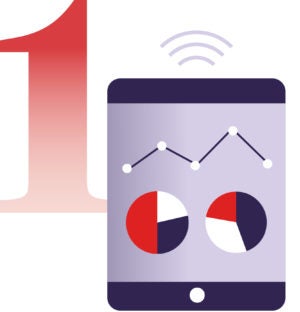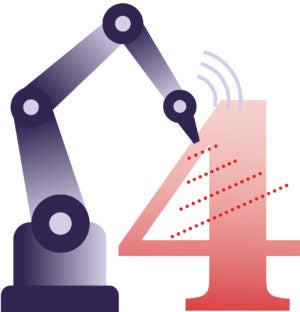 01 Predictive maintenance sensors
01 Predictive maintenance sensors
Ensuring equipment and machinery are running efficiently and optimally is critical to manufacturing output. The problem is most maintenance events are planned months in advance and, though they can prevent faults from occurring, it gives manufacturers little time to react if an asset or equipment breaks down unexpectedly. Schedules can’t foresee the future.
Artificial intelligence (AI) offers the ability to predict when events are likely to occur, so manufacturers can be prepared, react quickly and minimise any loss in productivity.
Sensors embedded in equipment and machinery will monitor operating conditions and tooling performance. These sensors will collate a wealth of information about an asset, both structured data – model number, year it was built, warranty details – and unstructured data – maintenance history and repair logs.
Once gathered, this data can be used by AI models to spot any anomalies, empowering manufacturers to take the preventative action before any fault occurs and minimise downtime.
 02 Inventory management drones
02 Inventory management drones
Manually capturing stock counts and managing inventory can be a laborious process. Some manufacturers will even halt operations to carry out a full inventory check.
Drones with AI capabilities are fast becoming an effective solution to this logistical challenge. Unlike their warehouse delivery cousins, these drones for auditing and inventory management can fit around production schedules because the only person who really needs to be present is a licensed drone pilot. This minimises downtime and also allows manufacturing teams to focus their efforts elsewhere.
Using an optical system combined with computer vision, drones can guide themselves to an assigned location, and use variable image and object recognition tools to identify and collect asset and inventory information, including from barcodes, QR codes and radio-frequency identification, or RFID, tags. This information can then be relayed to an integrated software platform.
Financial services giant EY is currently exploring the use of drones with AI capabilities to improve the quality of the auditing process.
 03 Chatbots for smoother customer service
03 Chatbots for smoother customer service
Away from manufacturing operations, AI will play a role in improving customer service and experience.
There are some queries that are better dealt with by machines, such as when customers want quick answers regarding their orders. The beauty of a chatbot utilising AI is it will learn from each conversation it has and then get better at predicting questions that will be asked, scripting answers, and providing more accurate and real-time information. Because the bot will know who it is conversing with, it can use this knowledge instantly to fetch information specific to the customer.
What’s more, machine-learning algorithms can be developed so the bot improves its understanding of how manufacturers operate. When integrated with other tangible forms of AI, it could inform customers of potential future problems with their orders, information that customer service personnel might not have to hand.
For example, if sensors detect that a piece of equipment is likely to break down, this could mean a temporary halt in production, which in turn could mean there’s a slight delay in orders being completed and sent out. By making customers aware of this, it will give them peace of mind and enable them to prepare for any delays that might occur their end as a result.
 04 Smarter ERP software
04 Smarter ERP software
All connected devices, sensors, chatbots and automated systems, from factory floor to finance office, can arguably only be effective if the data leveraged from the internet of things ecosystem is used in conjunction with enterprise resource planning (ERP) software.
Gartner predicts that by 2020 most new pieces of software released on to the market will leverage AI technology. Many experts also agree that smarter, AI-based ERP solutions are just around the corner. According to a report published in December by Evans Data, 58 per cent of developers working with AI are planning to integrate it into their ERP solutions or have already done so.
ERP is key to making strategic decisions and executing routine operational tasks. AI-based solutions will offer deeper insights and identify patterns that human workers would either miss or take far longer to spot. It also allows manufacturers to keep on top of trends and deliver real-time forecasting.
A caveat is that manufacturers will have to work alongside data scientists and consider upskilling their workforces. AI may make some low-level manufacturing roles obsolete, but at the same time it will increase the need for smarter employees, with knowledge of algorithms and machine-learning, and who can help cut through the clutter.
 05 Sensors embedded in products
05 Sensors embedded in products
While AI can help make the manufacturing process more efficient, embedding sensors into the products being manufactured also has its benefits.
If a company provides an end-to-end service, then it’s likely to offer off-site support and even a repair service too. As with factory floor maintenance typically scheduled months in advance, any routine checks are usually arranged ahead of time. Engineers are sent to customers’ locations even if no problems have been reported. This will often mean wasted fuel and man hours, resulting in poor productivity and decreased efficiency.
Integrating AI capabilities into products and monitoring their performance, and therefore their maintenance requirements, has a further advantage as manufacturers can see what they’re doing right, what’s going wrong and what can be improved. Data and insight gleaned can then inform future research and development decisions. This is a value-added service that can give manufacturers a competitive edge.
